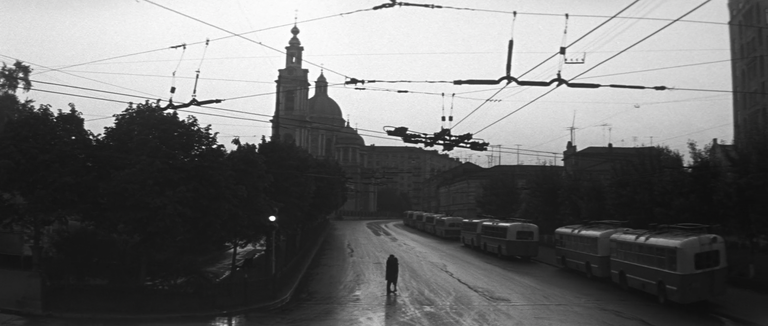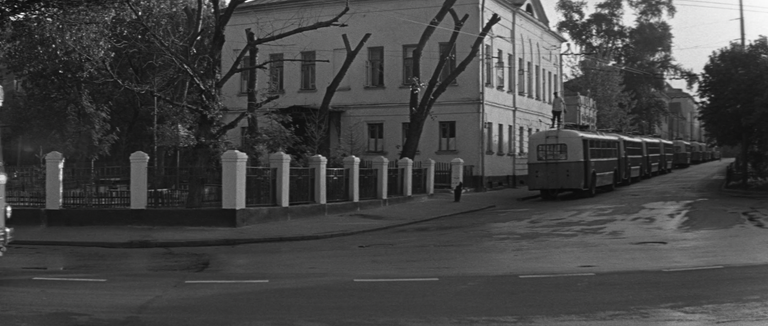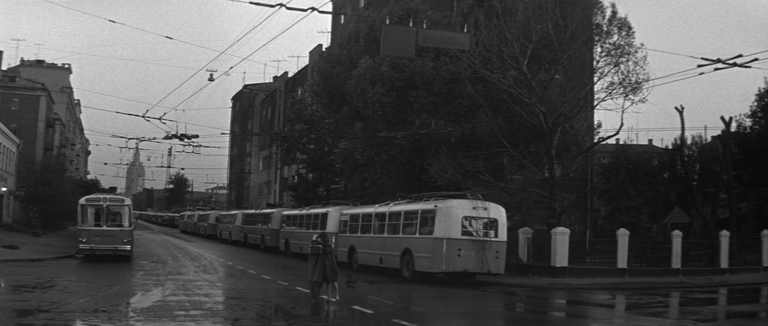'July Rain' by Marlen Khutsiev Review: An absolute beauty of a film

I have seen many films from the Soviet Union, and often enough they're incredibly poetic and reflective on the struggles of life. Here and there are some more common romance stories and dramas, however. Though a lot of the time these films tend to be very Soviet. Either in their identity of in reference to the general ideologies felt from the Soviet influence. It came as a massive surprise to find a film from the 60s, to which the Cold War had already started decades prior, and western influence was considered a major negative. The differences in these two nations were large, culturally and visually. It was in this decade of the 60s that much of the modernist Soviet architecture would be built, some of the Union's greatest architectural wonders would come to its various republics. Industry would see a massive boom as a result of strong growth that came from development in all region. Spirits high after the end of the Second World War which saw victory in the eyes of the Soviet Union. The aforementioned surprise comes in the fact that July Rain is not a Soviet film at all. It is not a film that comes from a communist mindset. It is a film that is in fact incredibly European, and heavily catering to western influence. Perhaps, to some degree, in this era the Cold War's height had not yet reached. And influence coming in from music and other areas of art would be considered highly difficult to obtain. Western music was effectively banned. Not sold off in stores, and not something one could easily hear on the radio.
Instead, July Rain is a film that defies a lot of the Soviet Union's agendas. It's one that really speaks of rebellion against the various censorships put into place that kept a lot of the arts well under control and effectively creatively stagnant. A reason why so many Soviet and even modern Russian films continue to focus on the nation's war efforts. Showcasing areas of triumph to the nation and pursuing propaganda to maintain belief in the government across its various lands. To see western music utilised within a film of this era is admittedly incredibly strange, though it suits the idea of youth and its rebellious nature, wanting to connect with the outside world a little more. Particularly in the idea of romance, to which the European style of music would heavily influence the population. I say much of this because one of the genuinely deciding factors of removing the communist ideology from the youth of Russia was the arrival of rock music. A genre that was often riddled with lyrics that were against government, authority, and generally telling the youth to rise up and demand their freedom against the oppressor. Though that isn't what this film is about, it's one on youth and discovering the self, trying to explore life and how the environment can inspire a mind. A love for the city, effectively. A lot of this is reflected in the shots of the city throughout the film, raw and without cinematic intent.
This film is available to watch for free from Mosfilm itself, on its YouTube channel. English subtitles are added into the film. Thankfully they seem to care about their preservation of media!

The film is heavily western in its inspiration from European films. The directing feels much like something out of France or Italy, perhaps even Spain to some degree. It holds some regard of familiarity to that of La Dolce Vita in how it displays a lot of wide perspectives of environments, showcasing a more artistic group of people that each talk and discuss their ideas of life and how to live it. It's a film that mostly displays the views of those that are somewhat younger, not necessarily teenagers or younger adults, but those about to hit their thirties and now having that question of what it is they really want from life: do they get married, have children, and stick to their current paths? Or do they change things up and go seeking for something new, testing what they're capable of? This is an interesting question to have from a nation in which most of these questions are answered for you. And that's what starts this film off with a more disconnected feeling from the Soviet Union. Alongside this, the film opens with many wide shots of the city, beautiful and sometimes anamorphic looking shots that showcase busy streets as everyday people navigate through them, many of which spend their time looking directly at the camera.
This approach makes the film often feel much more like a documentary. One that is displaying life in its truest form, showcasing a love for the environment in which the film takes place, a clear influence from its creators. We see shots of busy pathways with people walking, standing, or performing various tasks alongside beautiful western music. It holds similarities to European cinema more in the way that streets are utilised in a more natural way alongside music, where older streets of European cities are often associated with great beauty and inspiration within its inhabitants. Moscow still certainly holds much of that beauty itself, and with the wider focal length in which things are somewhat stretched and anamorphic looking, I think these ended up being some of my favourite scenes within the film. Even in the rain, to which the atmosphere is significantly heightened, and the use of rain is the backbone of the film's story: a woman given a jacket from an unknown man as the rain falls heavily. It's nothing out of the ordinary for a film to use the atmosphere of rain to convey emotion and romance, and the inevitable drama that comes with the two.

The more anamorphic look often shines in how it blurs the outer parts of the frame. And with long panning shots it actually somewhat morphs the surroundings in their shapes. Buildings become slightly elongated with movement. City streets that are mostly empty feel wider. It's a really cinematic and beautiful look to the film that I really enjoyed. And I think that's why I preferred the parts of the film that were more natural and exterior than the more interior scenes related to the story. With that aspect ratio of 2.35 : 1, I found the film to be much more engaging than other Soviet era films that tend to have significantly smaller boxed aspect ratios, which often give more of a feeling of being stuck and trapped within an area. The 2.35 : 1 aspect ratio actually works well in portraying the mind and how it suddenly rediscovers itself, how people learn and adapt and pursue new things when the world feels large and open to them. And that's the case of our female protagonist Lena, who realises her life isn't where she wants it to be, realising her partner isn't really suitable for her, and her friends aren't the audience she wants to be around. Leading to a more artistic pursuit of life around people with a similar mindset.
This film quickly became one of my favourite Soviet films. Such a unique story and atmosphere from the rest I've seen. The cinematography stunning. The music and atmosphere conveyed peaceful and poetic. The story on life and self-discovery one that each person can connect to. I highly recommend it. And to reiterate: this film is free to watch, officially!

I love Soviet films of the 60s. I'll watch this movie now.
I think it's quite a niche one. I had never managed to stumble across it before until today. Quite hard to find too, but yeah Mosfilm has it on their YouTube channel which is nice. I found it incredibly beautiful.
I read on Wikipedia that in the 1960s, officials limited its viewing and this film was watched by only 3 million people, in contrast to the same director’s film “Spring on Zarechnaya Street” (30 million views). I don’t remember this film even in the 1980-1990s. I enjoyed watching the episodes of everyday life of that time and the scene at the picnic. In the evening I’ll buy red wine and watch the whole movie.
I hope you enjoy it!
This doesn't surprise me at all. The fact that there's western music in it alone feels like it's begging for censorship in that era. Then there's the actual events within the film, to which I won't mention more of. :^)
пока!